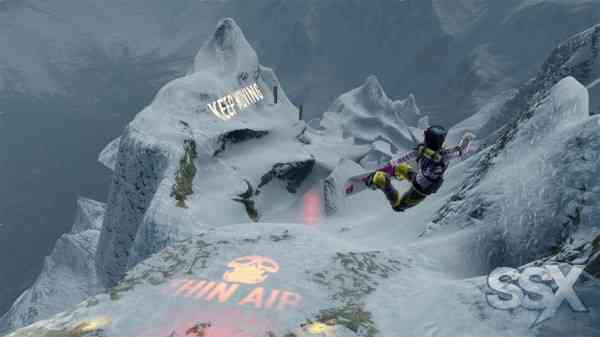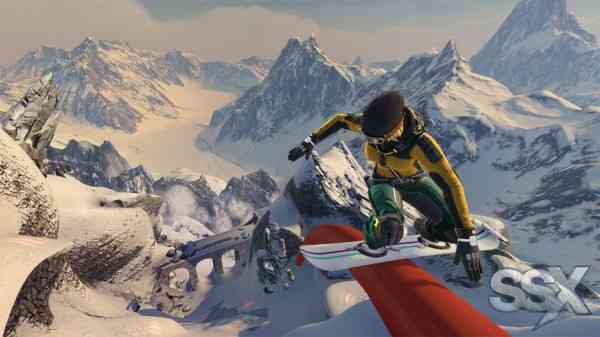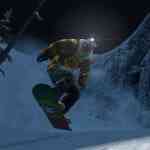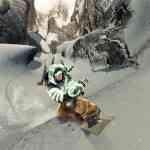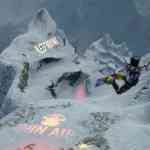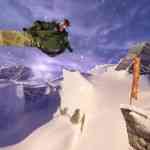In my opinion there is no good reason why it has taken so long for SSX to make an appearance on the current generation of consoles. The last true SSX game, SSX: On Tour, came out just a month before the current generation of consoles launched in 2005 (I don’t count SSX Blur on the Wii, sorry). 6 ½ years later I’ve finally gotten my hands on one of my favorite games and am in the middle of playing the absolute heck out of it as SSX has finally made its return.
When it was originally announced that a new SSX was in development, the game appeared to take a darker approach to the sport with the name Deadly Descents attached to it. Instead of the bright and colourful visuals that have been a staple of the series, a darker tone was set with wing suits, ice aces, and many environmental elements to cause you harm. SSX has definitely steered back more towards its roots since that original announcement. Diehard fans of the series need not worry about the core gameplay as it is still intact and completely over the top. Let’s make one thing clear here though for anyone that’s new to the series, SSX has never been about realism; it is all about over-the-top environments, speed, vertical and lots of tricks.
There is a bit of story this time around and it takes place during the game’s World Tour mode. It revolves around beating an ex-SSX team member to conquer nine “deadly descents” around the globe. The World Tour mode really just serves to introduce you to the characters and the locales though and you can get through it in about six to eight hours. The bulk of your play time is going to be spent in Explore or Global Events modes that allow you to freely choose which mountains and events to run when you want and these pit your scores, times, and results in real time against friends and other players from around the world. While the plot in the World Tour mode is pretty thin I suggest playing through it to unlock the various characters and environments. It acts as a good primer for the Explore mode which allows you to compete in events as you choose. Events have times and scores to beat to earn in-game medals. If you’re connected online, you can also compete against friends via RiderNet.
Just like Need For Speed had Autolog, SSX has its own means of connecting you with your friends called RiderNet. RiderNet allows you to easily see when your friends have bettered your time or score on a specific track and you can quickly jump to that event to answer that challenge. RiderNet isn’t as much its own mode rather than it spans all the different game modes. You can not only see what your friends are doing in such things as a Global Event, but you can also create your own custom challenges for anyone, or just your friends, to play and compete on. There’s just so much to do here you’ll find yourself frequently jumping from World Tour mode into RiderNet to challenge a friend or something. By the way, if you want to do online in the traditional manner with your friends at the same time, creating custom challenges is how you do it. Another neat feature is that you can also place Geotags in and around levels for your friends to find. Not only do you get credits for finding them, you earn credits for placing them in difficult to reach places. The longer one of your Geotags goes without being found, the more credits you earn.
Global Events are events and challenges that anyone can take part in but are only open for a limited amount of time. There is a small fee to enter these events paid for with in-game credits. All of the entry fees are pooled together and paid out according to how well you do. In a nice effort to segment different skills of gamers there are several tiers, and depending on how you score you are slotted into a tier so you are competing against those of similar skill. An example of this is that in my first Global Event my first run totalled 14M trick points. The overall leader scored 81M points. My score slotted me into one of the middle tiers. As a more casual gamer, without such a tiered system I would have no chance in competing. EA’s done a good job in making this mode accessible to all.
There are nine locales based on real world environments such as Alaska, Sibera, Antarctica and the Rockies to name a few. EA’s used some interesting technology to build the terrain too (Satellites are involved). It doesn’t have a lot of bearing on this review but if you’re interested in the game’s level design it is worth looking up online in their developer diaries. Exclusive to the PS3 version is the inclusion of Mt. Fuji as a playable locale. Each locale in the game has a distinct theme and each theme is represented in the Deadly Descent events in World Tour. These events act as a boss battle before you can move on to the next locale in the World Tour mode. For example, the Deadly Descent in the Rockies has you navigating a tight gully full of trees whereas the Deadly Descent in Siberia has you racing down hard icy slopes which force you to use the ice axes and many well-timed jumps to clear crevasses. While the game touts open-world environments I found the individual drops surprisingly tight. There are multiple paths you can choose from but it doesn’t feel as open world as promised and perhaps less open than even SSX Tricky.
Events break down into three types: races, trick events, and survival events. The race and trick events are the core SSX experience. Survival events have a single simple goal: survive and finish the event. Completing events earns you in-game credits which allows you to unlock new characters and equipment. Going beyond just the traditional outfits and boards from previous games, you can now equip such things as armour and ice axes depending on what type of race you are running. Certain events require specific equipment. You can also equip one-off mods such as speed and trick boosts. These come at a lower cost than buying a new board or something else, but they are only good for that one race. All of this new customization centers around a survival probability score at the bottom of the equipment screen for each race. You can dig into the customization to optimize your chance of surviving an event as far as you want or you can simply choose a one-click optimizer that does the work for you.
EA has also implemented dual stick controls to SSX. Whereas in past games you performed grabs and tricks using the face buttons this is all mapped to the right stick now and is directional based. You push up to grab the front of the board, left to grab with your left hand, and so on. To trick, you combine whatever directions your mind can come up with. It is actually quite deep. You can grab different sides of the board with one hand or another. You can still tweak all moves with the right trigger and you impart whatever spins and flips you want with the left stick while in the air. For those that feel more comfortable with the classic button controls they are intact if you want to use them. I was a button masher in the previous SSX games but now I am madly flipping the right stick in whatever direction I can. Overall, the controls are very tight and you will be carving wicked lines in no time at all.
The traditional SSX scoring system is back as well. You earn both points and boost as you do tricks. As you string tricks together your boost meter fills. You can use boost to go faster down the hill or just let it build up. When the boost meter is full you enter Tricky mode (complete with Run DMC music, thank you) where your tricks and abilities are temporarily boosted. Keep up the tricks and you go into uber-Tricky mode where your boost is unlimited and you can perform signature moves for each character. The twist is that it has impact regardless of event type. You have to do tricks to earn boost so it becomes critical to do so in races if you’re looking to get the gold medal or best your friend’s times.
Visually, two things stand out to me when it comes to how SSX looks. First off, the game is fast and smooth. You won’t see a lot of hitches in the frame rate here and everything is buttery smooth. A few times things were so fast paced that I actually lost my sense of direction and I thought that was pretty neat. The second thing is the scale of each of the locales. The mountains are big and each locale around the globe has a distinct styling to it. Siberia is full of ice, crevasses and industrial plants and pipes while the Rockies are steep, vertical and full of trees. The trademark SSX look with bright neon colours and over-the-top environments is intact. As I mentioned earlier, the different environments aren’t as open as I expected but they still look damn good. Characters are well detailed and their animation is smooth. The tricks in SSX are so over the top though that a lot gets lost on the player. Characters bend, twist and spin so quickly in the air it all becomes a blur. There are plenty of special effects to keep the sizzle going including Tron-like glowing outfits and even fiery particle effects when you enter the uber-Tricky mode.
There’s so much going on visually in SSX that the sound has taken a sort of back seat in my playtime with the game. This doesn’t mean it is bad by any means. Most prominent is the soundtrack which has an electro-hypnotic vibe to it and dynamically changes with the action, often slowing down to enhance something like big air and tricks. It even does this to your own tunes if you use custom soundtracks. There’s also plenty of dialogue. DJ Atomica is back and individual characters all have token lines as well which are performed adequately. The rest of the sound effects are what one would expect. With a good surround sound setup the wind will howl around the room and the sound of your edge trying to grip into icy slopes is excellent.
Whether it is trying to get gold medal scores in all of the events, besting your friend’s times or scores, or searching for collectibles, there is so much to do in SSX. It is one of those games that drives me to want to finish it 100%. Thanks to the excellent RiderNet you are always being pulled in different directions much like sandbox games like GTA have you deviating from the main storyline. RiderNet is already a big hit within our community too. This is a fine return to the SSX series and it is a very good game for sure.

